ECW1
1/179
There's no tags or description
Looks like no tags are added yet.
Name | Mastery | Learn | Test | Matching | Spaced |
|---|
No study sessions yet.
180 Terms
Economics
The science of human cooperation, focusing on how people and institutions make decisions about the production and consumption of goods and services.
Human cooperation
The way people and institutions make decisions about producing and consuming goods and services and how they face the problem of scarcity.
→ essentially a study of the ways in which humankind provides for its well-being
What is a good model ?
Clear
Predicts accurately
Improves communication (help understand what we agree and disagree about)
Useful → Can be used to improve the economy
GDP (Gross Domestic Product)
A measure of the market value of the output of final goods and services in the economy in a given period, usually expressed in per-capita terms.
Disposable income
Total income - taxes + Government transfers
Industrial Revolution
A wave of technological advances starting in Britain in the 18th century, which transformed an agrarian and craft-based economy into a commercial and industrial economy.
→ gave rise to unprecedented improvements in productivity
Environmental consequences
Global impacts – climate change
Local impacts – pollution in cities, deforestation
Conditions to Malthus’ Law
Diminishing average product of labor
Rising population in response to increases in wages
An absence of improvements in productivity to offset the diminishing average product of labor
Capitalism
An economic system in which private owners of capital hire labor to produce goods for sale on markets with the intent of making a profit.
Firms
One or more individuals own a set of capital goods that are used in production
They pay wages and salaries to employees
They direct the employees (through the managers they also employ) in the production of goods and services
The goods and services are the property of the owners
The owners sell them on markets with the intention of making a profit
Forms of economic organization that coexist with firms in capitalistic systems
Family or individual production (they do not hire others)
Nonprofit organizations (they do not seek to make profit or sell their output on a market)
Cooperatives (labour is not hired, work is done by members)
Government bodies (they do not seek profit; capital goods are not privately owned)
Private Property
The right of individuals to exclude others from using or benefiting from something they own.
Capital goods
The durable and costly non-labour inputs used in production (machinery, buildings) not including some essential inputs, (e.g. air, water, knowledge that are used in production at zero cost to the user.)
Markets
A way that people exchange goods and services by means of directly reciprocated transfers (unlike gifts), voluntarily entered into for mutual benefit (unlike theft, taxation), that is often impersonal (unlike transfers among friends, family).
Why did capitalism led to growth ?
impact on technology: firms competing in markets had strong incentives to adopt and develop new technologies
specialization
Specialization
The process by which individuals focus on a limited range of tasks or production activities to increase efficiency and productivity.
Gains from specialization
• learning by doing
• taking advantage of natural differences in skill and talent
• economies of scale
=> People can only specialize if they have a way to acquire the other. goods they need. In a capitalist society, this is done via markets.
Malthusian Trap
A situation where increases in population outpace increases in resources, leading to subsistence-level living conditions.
Capitalism and democracy
Most countries: Capitalism coexist with democracy
Rule of law - all individuals bounded by the same laws
Civil liberties - Rights of free speech, assembly, press
Inclusive, fair and decisive elections
BUT: capitalism can co-exist with non-democratic systems
Flat World
A term referring to a state of global economic disparity where many regions do not experience growth in standards of living.
Diminishing Average Product of Labour
The principle that as more labor is added to a fixed amount of capital, the additional output from each new worker will eventually decline.
Scarcity
The fundamental economic problem of having seemingly infinite human wants in a world of limited resources.
Market Economy
An economic system based on supply and demand with little or no government control.
Comparative Statics
A method used in economics to compare two different economic outcomes, typically before and after a change in some parameter.
Behavioral Economics
A field of economics that examines the effects of psychological factors on the economic decisions of individuals and institutions.
Economic Systems
The means by which countries and governments distribute resources and trade goods and services.
Coreecon
A term relating to the core concepts of economics outlined in the educational materials or resources used in this course.
Human Progress
The advancement of human society through improvements in living standards, health, and technology over time.
Opportunity Cost
The loss of potential gain from other alternatives when one alternative is chosen = Net benefit of the next best alternative action
→ Homo-economicus: Compare actions to economic costs
Economics
The study of how society manages its scarce resources.
Growth
Not distributive → The elephant curve
Production functions
How inputs (e.g. labour) translate into outputs (e.g. goods and services), holding other factors constant(e.g. production environment)
Marginal Product
Change in output per unit change in input (evaluated at a given point, holding other inputs constant)

Average product
Average output per unit of input
Reservation option
Next best alternative
Economic cost
Direct costs incurred by taking an action + opportunity cost
Economic Rent
Net benefit from option taken – opportunity cost
Assumptions of Model of constraint choices
Individuals want to consume as much as possible
They want as much free time as possible
+ No saving or borrowing
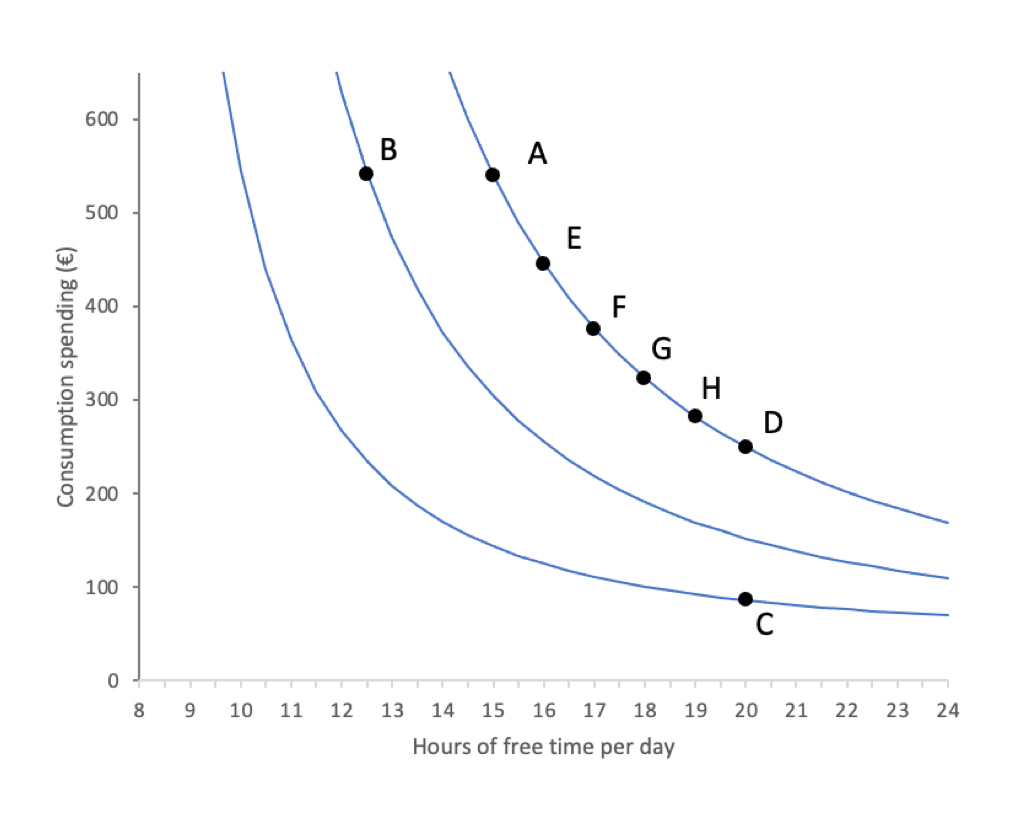
Indifference curve
All the combination of goods that give the same utility (=satisfaction)

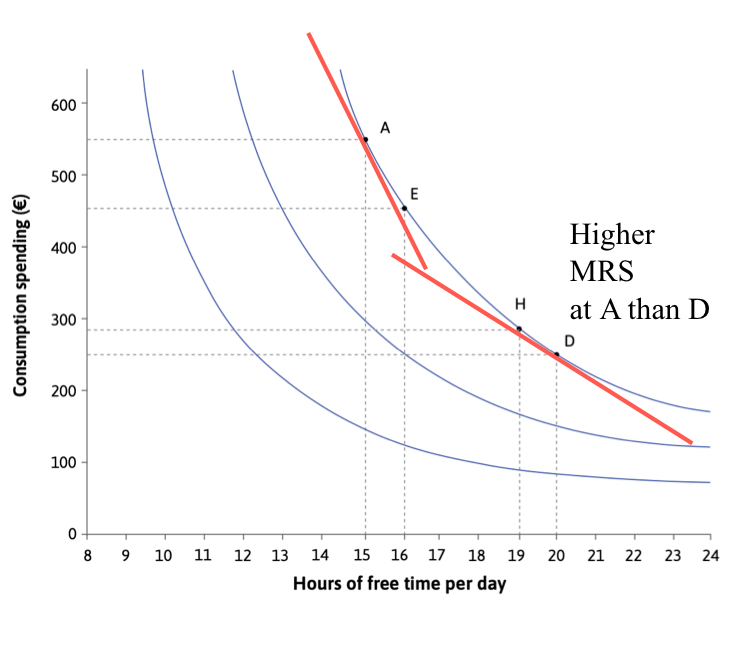
Marginal rate of substitution
Measure of the trade-off someone is willing to make (eg. between consumption and free-time)

Feasible frontier
Maximum output that can be achieved with a given amount of input
Formula for maximum level of consumption
C = w(24-t)
Marginal rate of transformation
Slope of the feasible frontier. Represent the rate at which (for eg.) free time can be transformed into consumption.

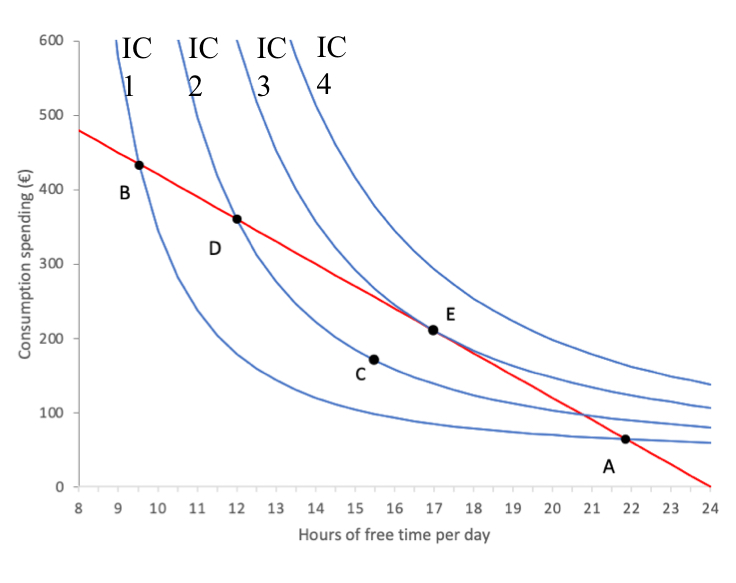
Constrained choices → Utility maximizing choice
MRS = MRT
The amount of one good the individual is willing to trade off for the other good (MRS) equals the actual tradeoff between the two goods (MRT).
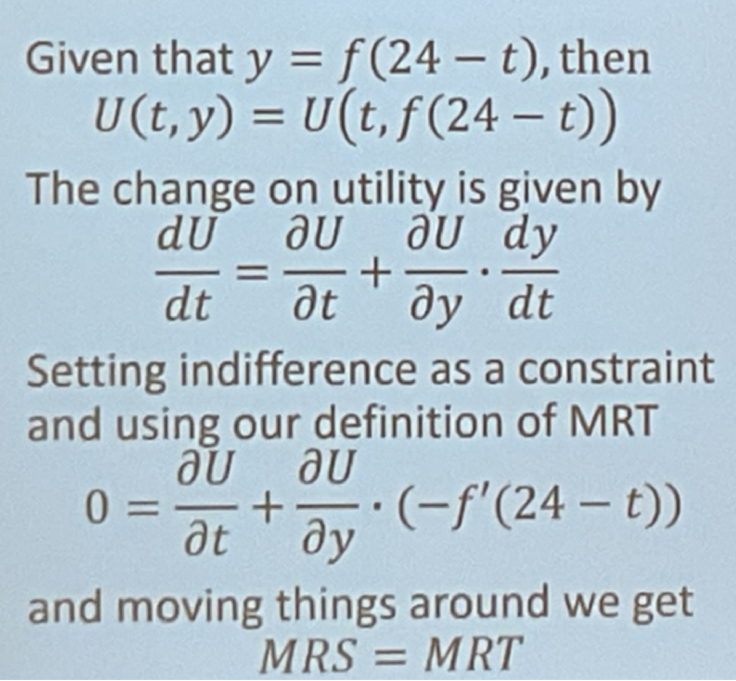
Budget constraints
Feasible frontiers for consumption choices
Income effect
Your total earnings increase, holding working hours fixed
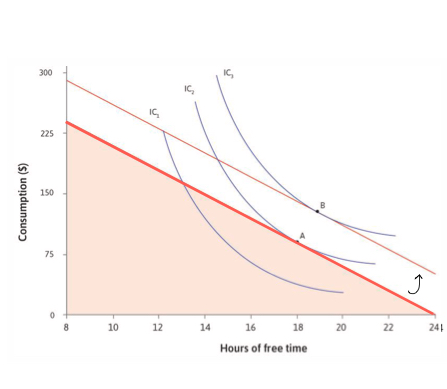
Substitution effect
The change in optimal choice when the opportunity cost changes, at the new level of utility
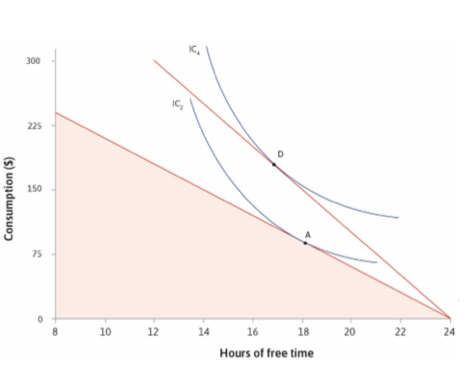
Overall effect on labor choice
Income effect + Substitution effect
Technological progress
Makes it feasible to both consume more and have more free time.
Veblen effect or conspicuous consumption
The more rich people consume, the longer other people will work, so as to try to copy (as best they the can) the standards of the rich.
→ We would expect people to work longer hours in countries in which the rich are especially rich, and people to work less where the rich are only modestly richer than the rest.
Explanations to differences un working hours across countries
Social preferences
Differences in culture
In politics
Social dilemma
A situation in which actions taken independently by self-interested individuals result in a socially suboptimal outcome.
E.g.: traffic jams, climate change
Best response
Strategy that yields the highest payoff, given the other player’s strategy
Dominant strategy
A best response to all possible strategies of the other player (does not always exist!)
Dominant-strategy equilibrium
An outcome of a game in which everyone plays their dominant strategy
Nash equilibrium
All players simultaneously choose a best response + None of the players can improve by deviating unilaterally
• Interpretation 1: the result of players’ independent optimization in the light of others’ presumed rationality
• Interpretation 2: self-enforcing agreements players can reach
Allocation
Outcome of an economic interaction
Way to reach the best equilibrium
Communication between players
BUT If there is more than one Nash equilibrium, the Pareto optimal outcome may not be selected.
→ Society could be ‘stuck’ in a suboptimal outcome since there is no incentive to unilaterally change one’s action.
Aesop’s social dilemma
Mice’s wanting to bell the cat
Prisoners’ Dilemma
Dominant strategy equilibrium, in which playing the dominant strategy yields lower individual and total payoffs compared to other strategies.
Tragedy of the Commons
In 1968, biologist Garrett Hardin coined ‘the tragedy of the commons’
→ A common = common property = common-pool resource = a resource not owned by anyone
• The earth’s atmosphere
• Fish stocks
=> Risk of overexploitation
When is the Pareto optimal outcome achieved in a social dilemma ?
Players only care about their own payoffs
• Solutions: commitment, social preferences
• Nobody can make players pay for the effects of their actions on others
→ Solution: repeated interaction
Altruism
Social dilemmas → when players only care about their own payoffs.
BUT In experiments, many players show altruism by choosing the dominated strategy.
→ Altruistic preferences affect the shape of indifference curves
Inequality aversion
Disliking outcomes in which some individuals receive more than others
Reciprocity
Disliking outcomes in which some individuals receive more than others
Ultimatum Game
Sequential game wherE players choose how to divide up economic rents (cash, chocolates)
→ The proposer’s offer may be motivated by altruism, inequality aversion, social norms, or reciprocity.
Effect of introducing competition ?
Moves outcomes closer to the self-interested outcome → ‘The name of the Game’
Consequences of Repeated games
Social dilemmas can sometime be resolved in repeated interactions due to peer punishment.
→ Behaving selfishly in one period has consequences in future periods, so it may no longer be a dominant strategy.
Name of the Game Liberman
Key Empirical Findings:
Situational Framing Over Individual Reputation:
Participants were significantly more likely to cooperate when the game was called the "Community Game" rather than the "Wall Street Game."
This effect was observed in both American college students and Israeli Air Force trainees.
Reputation-based predictions by peers and instructors failed to predict whether individuals would cooperate or defect.
Behavioral Shift Due to Labels:
The label affected not only first-round decisions but also shaped the cooperation rates over multiple rounds.
In the Community Game, mutual cooperation was significantly higher.
In the Wall Street Game, defection dominated, even among those predicted to be cooperative.
Laypeople’s Incorrect Predictions:
Individuals expected stable cooperation or defection based on personality, but actual behavior was shaped largely by the game's name.
Even when asked to reassess predictions with different labels, forecasters underestimated the impact of framing.
Relation to Classical Economic Theory:
Rational Choice & Self-Interest:
Classical economics assumes that individuals act based on self-interest, choosing strategies that maximize personal gain.
The study contradicts this by showing that simple labeling effects can override stable, rational preferences.
Stable Preferences vs. Context-Dependent Behavior:
Classical economic models assume individuals have stable preferences.
The results indicate that behavior is highly context-dependent, aligning more with behavioral economics and psychology.
Game Theory Predictions:
Standard game theory would predict defection as the dominant strategy in a Prisoner's Dilemma.
However, cooperation rates varied significantly based on labels, suggesting that norms and social expectations influence strategic decision-making.
Nash equilibrium.
Each player's strategy is the best response to the strategies of others.
Who and what are the “Rules of the Game”
Institutions. They provide the constraints (what we can’t do) and the incentives (what you’ll get if you do something).
Power
Ability to do and get the things we want in opposition of the intentions of others.
Structural power
A person’s structural power is the value of their next best alternative. A person’s structural power is limited by the structural power of the other. Eg: Applying for a job while knowing you can get a better salary somewhere else
Bargaining power
A person exercising bargaining power may set the terms of an exchange and/or impose, or threaten to impose, heavy costs. Eg: Being good at convincing
Pareto criterion
An allocation A is better than allocation B if at least one party would be strictly better off with A than B, and nobody would be worse off. (‘better off’ means that they prefer it, not necessarily that they get more money)
Pareto efficiency
An allocation is Pareto efficient if there is no feasible alternative allocation in which at least one person would be better off, and nobody worse off.
Why could allocations be called unfair ?
How unequal the allocations are: In terms of income, for example, or subjective wellbeing. These are called substantive judgements of fairness (e.g. inequality, inequity).
How the allocations came about: For example, by force, or by competition on a level playing field. These are called procedural judgements of fairness.
Ways of evaluating institutions, legitimacy of voluntary exchange
Were the actions resulting in the allocation the result of freely chosen actions by the individuals involved? Or was fraud or force involved?
Ways of evaluating institutions, equal opportunity
Did people have an equal opportunity to acquire a large share of the total to be divided up? Or were they subjected to some kind of discrimination or other disadvantage because of their race, sexual orientation,gender, or who their parents were?
Ways of evaluating institutions, deservingness
Did the rules of the game that determined the allocation take account of the extent to which an individual worked hard, or otherwise upheld social norms?
John Rawl’s three steps for deciding wether an allocation is fair
Justice is impartial, fairness applies to everyone
Imagine a veil of ignorance
From behind the veil of ignorance, we can make a judgment
2 evaluation of the impact of an economic policy
Is this allocation efficient ?
Is the allocation fair ?
Feasible frontier
All the technically feasible outcomes (limited by technology)
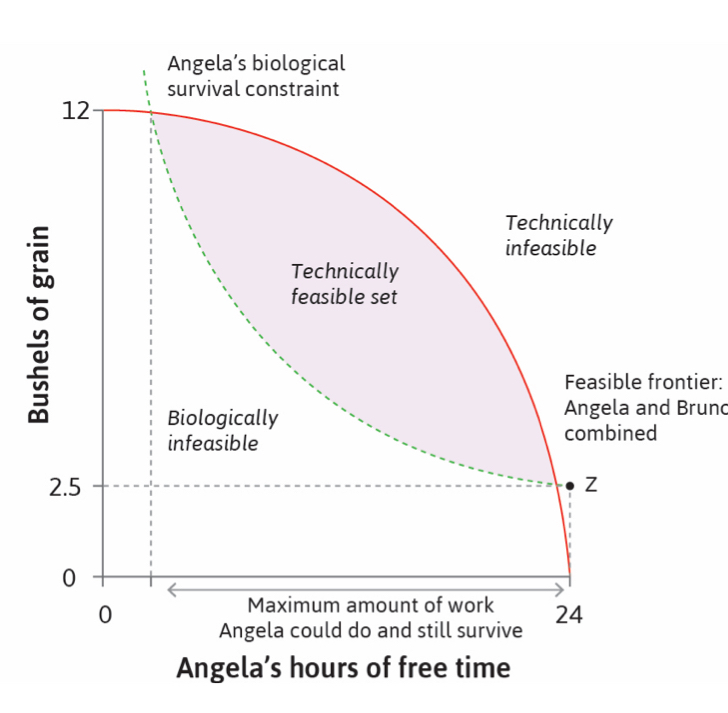
Biological survival constraint
All the biologically feasible outcomes (limited by survival)

What happens under coercion
The allocation chosen is where the slope of the biological constraint equals the slope of the feasible frontier
What happens without coercion ?
Joint surplus is maximized where the slope of the reservation indifference curve equals that of the feasible frontier
2 properties of a Pareto efficient allocation
The MRT on the feasible frontier is equal to the MRS on Angela’s indifference curve
No xxx is wasted
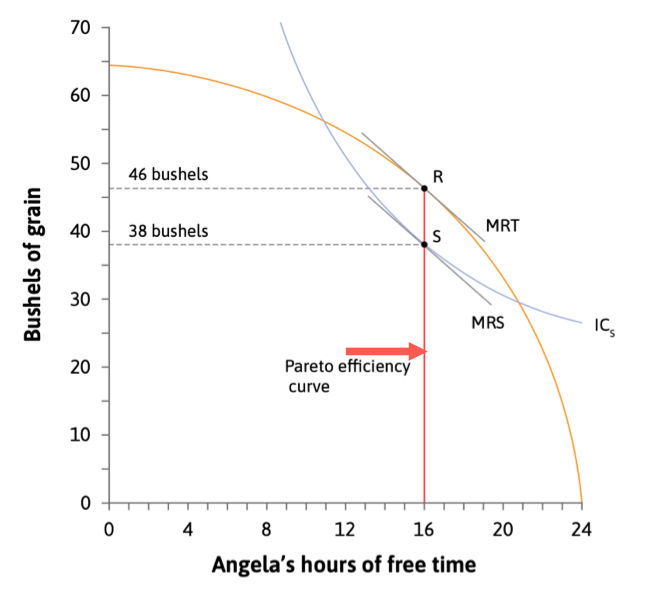
Endowments
Things that allow people to receive income: financial wealth, assets they own, intellectual property, knowledge/skills, race/gender/age, citizenship they have
Economic inequality
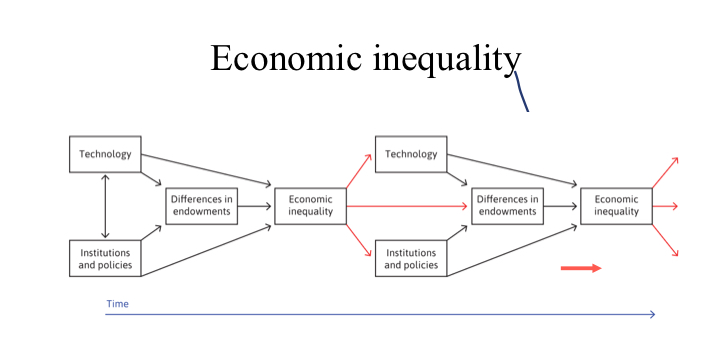
Gini coefficient for incomes
One-half times the average difference in income divided by the average income
Lorenz curve
Graphic representation of inequality of some quantity (wealth, income)
→ The extent to which the curve falls below this perfect equality line = measure of inequality
Market vs disposable income
Disposable income= Market income (from wages, salaries, self-employment, business, investment) - direct taxes + cash transfers
Weakest Link Game (paper)
Empirical Findings from the Study
1. Coordination failure was common
- Classical economic theory predicts that rational players should converge toward the Pareto-optimal equilibrium (where everyone chooses the highest number, 7).
- However, in practice, participants frequently failed to reach the best equilibrium, instead settling at lower, inefficient choices.
2. Path dependence in coordination
- Players' initial choices significantly influenced long-term outcomes.
- Classical theory assumes rational agents will always optimize, but the experiments showed history and expectations shaped decision-making, causing players to get "stuck" in inefficient equilibria.
3. Larger groups performed worse
- Standard economic models suggest that larger groups should not necessarily reduce efficiency if players act rationally.
- However, empirical results showed that as group size increased, efficiency declined because the probability of a low-action choice increased.
- This contradicts classical predictions that more participants should lead to greater overall knowledge and efficiency.
4. Public information improved expectations but did not prevent decline
- Classical theory would predict that revealing others' past decisions should help coordination.
- While public information led some players to attempt higher choices, it was not enough to prevent the lowest-number players from dragging the group down.
5. Aggregation of groups reduced efficiency
- Classical economics assumes that combining two well-functioning groups should maintain or improve performance.
- However, when two groups merged, the new group almost always ended up at the lower equilibrium.
- This suggests behavioral inertia and risk aversion played a larger role than rational optimization.
Relation to Theoretical Predictions from Classical Economics
- Deviation from Nash Equilibrium: Classical game theory suggests that rational players should settle on the highest equilibrium, but experimental results showed persistent failures due to risk aversion and expectation mismatches.
- Social Complexity and Bounded Rationality: Unlike the assumption of perfect rationality in classical models, the findings suggest players rely on heuristics and past experiences, leading to inefficient outcomes.
- Group Dynamics and Coordination Costs: The negative impact of group size contradicts classical predictions that more agents should lead to improved efficiency through information sharing.
Absolute advantage
The ability to produce a good or service more efficiently than another entity, using the same or fewer resources.
Comparative advantage
The ability to produce a good or service at a lower opportunity cost than another entity. Even if one country has an absolute advantage in producing multiple goods, it should specialize in the one where it has the greatest comparative advantage (i.e., the lowest opportunity cost) and trade for the other goods.
Technology
A process that uses inputs to produce an output
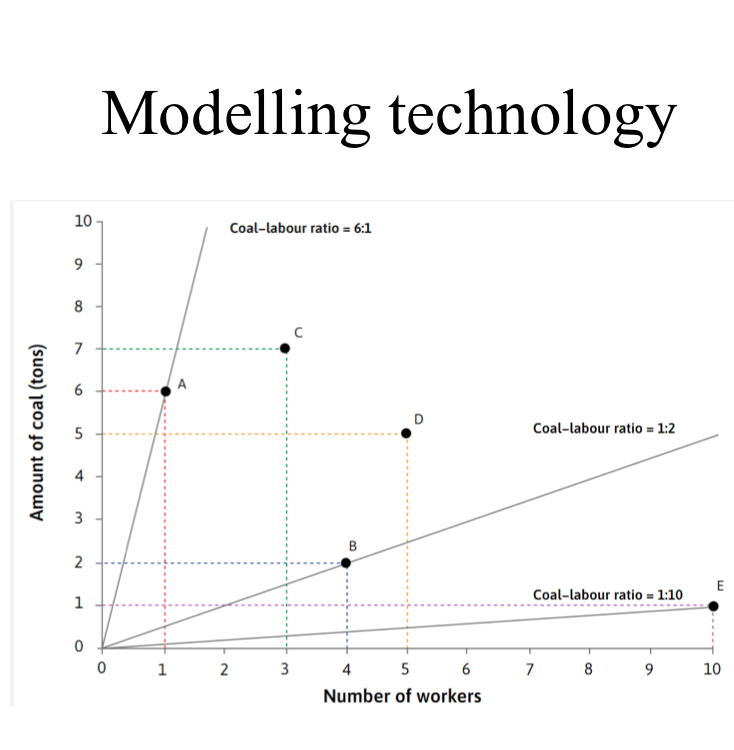
Cost (formula)
= (wage x workers) + (price of a tonne of coal x numbers of tonnes)
= (w x L) + (p x R)
Isocosts lines
Combinations of inputs that give the same cost (slope=relative price of inputs)
Slope of isocost lines = relative price of labor
- w/p
(w = wage/ p = price)
Law of diminishing average product of Labour
If we hold one input (land) fixed, and expand the other input (labour),the average output per worker is going to fall.